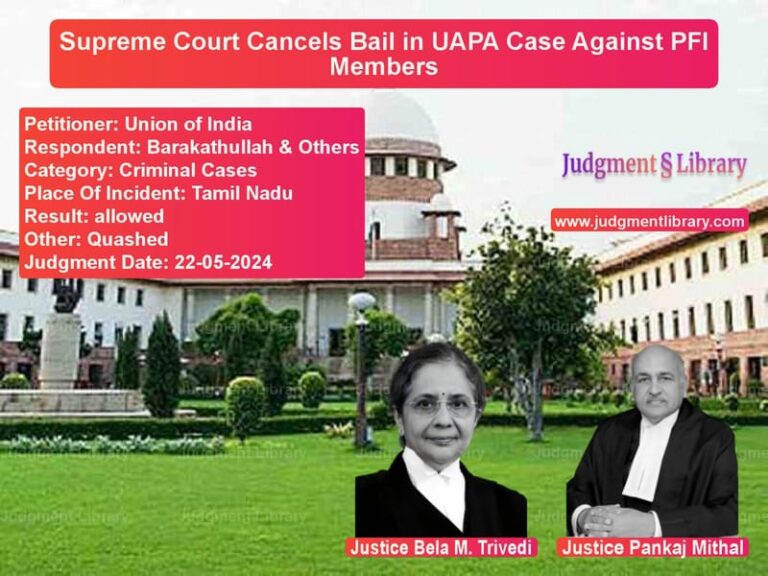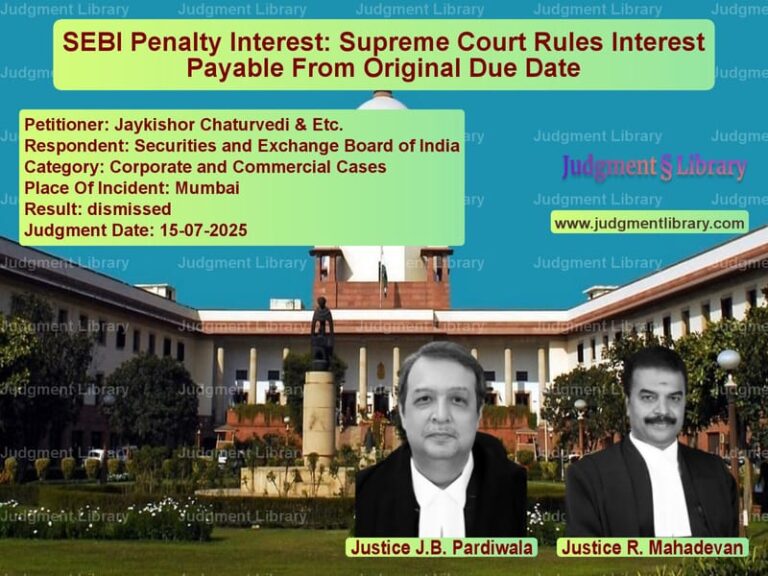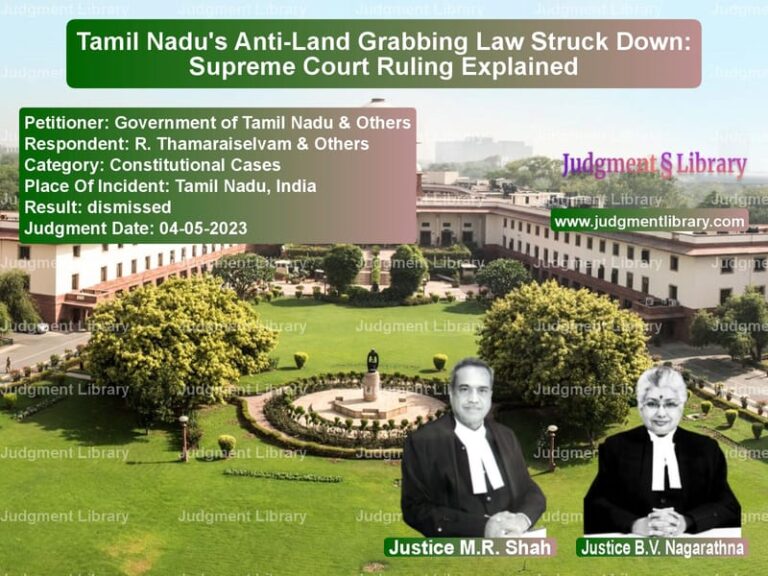Supreme Court Upholds Conviction in Punjab Murder Case Based on Circumstantial Evidence
The Supreme Court of India, in the case of Sukhpal Singh vs. State of Punjab, upheld the conviction of the appellant under Section 302 IPC for murder. The case, built entirely on circumstantial evidence, involved the recovery of the deceased’s body near a canal, last-seen evidence, and forensic analysis linking the accused’s service revolver to the bullet retrieved from the victim’s body. The Supreme Court reaffirmed that a conviction based on strong circumstantial evidence can stand even if motive is not clearly established.
Background of the Case
The case originated on June 27, 1993, when an unidentified body was discovered near a canal in Punjab. Following an investigation, the appellant, Sukhpal Singh, a police officer, was charged with murder along with another co-accused under Section 302 read with Section 34 IPC and Section 201 IPC for destroying evidence.
The prosecution relied on three key circumstantial links:
- Last-seen theory: The deceased was last seen with the accused.
- Recovery of the murder weapon: A .38 caliber revolver, allegedly used in the crime, was recovered from the accused’s house.
- Forensic evidence: The bullet recovered from the deceased matched the appellant’s service revolver.
The Trial Court found the appellant guilty, sentencing him to life imprisonment. The co-accused was acquitted. The Punjab and Haryana High Court upheld the conviction, leading to an appeal before the Supreme Court.
Arguments by the Appellant
The defense argued:
- The case was based on circumstantial evidence with no direct eyewitness testimony.
- The last-seen theory relied on testimonies from relatives of the deceased, which were allegedly biased.
- The accused had been placed under suspension before the crime, and his revolver was deposited at the police lines.
- The forensic report was unreliable, and the bullet could have been planted.
- There was no established motive for the crime.
Arguments by the State of Punjab
The prosecution contended:
- The appellant was last seen with the deceased, and the circumstantial evidence formed a complete chain proving his guilt.
- The accused’s service revolver was recovered along with live and empty cartridges.
- The forensic analysis confirmed that the bullet recovered from the victim’s body was fired from the appellant’s revolver.
- The accused failed to provide a reasonable explanation for the presence of the murder weapon.
Supreme Court’s Analysis and Judgment
The Supreme Court examined the three key circumstantial links:
1. Last-Seen Theory
Three witnesses—PW7, PW8, and PW9—testified that the appellant was last seen with the deceased.
- PW7, the brother-in-law of the deceased, stated that the deceased left the taxi stand with the accused on June 26, 1993.
- PW8 testified that he saw the accused sitting in the deceased’s taxi near a canal.
- PW9, a security guard, confirmed that he saw the deceased with the appellant before the incident.
The Court held:
“The testimony of these witnesses, which has been believed by the trial court and High Court, establishes that the appellant was last seen with the deceased.”
2. Recovery of the Service Revolver
The appellant’s service revolver was recovered from his house based on his disclosure statement. Along with the revolver, three live cartridges and two empty cartridges were found.
The Court ruled:
“The recovery of the revolver was legally valid and corroborates the prosecution’s case.”
3. Forensic Examination
The forensic report confirmed that the bullet extracted from the deceased was fired from the appellant’s revolver.
The Court observed:
“The ballistic report clearly links the appellant’s weapon to the crime, leaving no reasonable doubt.”
4. Lack of Motive
The defense argued that the prosecution failed to establish a motive. However, the Court held:
“While motive strengthens circumstantial cases, its absence does not nullify strong forensic and eyewitness evidence.”
Final Judgment
- The Supreme Court dismissed the appeal, upholding the conviction.
- The life imprisonment sentence under Section 302 IPC was affirmed.
- The Court ruled that the circumstantial evidence formed a complete chain leading to the guilt of the appellant.
Key Takeaways from the Judgment
- Last-Seen Theory Holds Strong in Absence of Direct Evidence: If the accused is last seen with the victim and fails to explain their whereabouts, it strengthens the prosecution’s case.
- Forensic Evidence is Crucial: The ballistic report linking the murder weapon to the accused played a decisive role in upholding the conviction.
- Recovery of the Murder Weapon is Strong Circumstantial Proof: The voluntary disclosure and recovery of the accused’s revolver further corroborated the prosecution’s case.
- Absence of Motive is Not Fatal in a Case with Strong Circumstantial Evidence: The judgment reinforces that motive, while important, is not indispensable.
Conclusion
The Supreme Court’s ruling in Sukhpal Singh vs. State of Punjab sets a precedent in cases relying on circumstantial evidence. The judgment reinforces that when circumstantial evidence—such as last-seen testimony, forensic proof, and weapon recovery—forms a complete chain, a conviction can be sustained even in the absence of a proven motive. This ruling ensures that offenders cannot evade justice merely due to the lack of direct eyewitnesses.
Petitioner Name: Sukhpal Singh.Respondent Name: State of Punjab.Judgment By: Justice A.M. Khanwilkar, Justice K.M. Joseph.Place Of Incident: Punjab.Judgment Date: 12-02-2019.
Don’t miss out on the full details! Download the complete judgment in PDF format below and gain valuable insights instantly!
Download Judgment: Sukhpal Singh vs State of Punjab Supreme Court of India Judgment Dated 12-02-2019.pdf
Direct Downlaod Judgment: Direct downlaod this Judgment
See all petitions in Murder Cases
See all petitions in Judgment by A M Khanwilkar
See all petitions in Judgment by K.M. Joseph
See all petitions in dismissed
See all petitions in supreme court of India judgments February 2019
See all petitions in 2019 judgments
See all posts in Criminal Cases Category
See all allowed petitions in Criminal Cases Category
See all Dismissed petitions in Criminal Cases Category
See all partially allowed petitions in Criminal Cases Category







